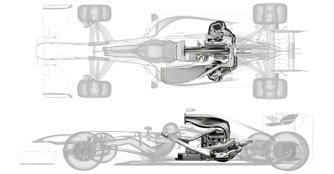Renault unveils 1.6-litre F1 engine for a new era
23 Jun 2013|5,174 views
In 2014, Formula One will enter a new era with the introduction of a new generation of power units that will combine a 1.6-litre V6 turbocharged engine with energy recovery systems. They will dramatically increase efficiency by harvesting energy dissipated as heat in the exhaust or brakes. The new generation powertrain - Energy F1-2014 - was unveiled by Renault reflecting synergies with the pioneering fuel efficient Energy engine range used in Renault road cars.

"From 2014 we will bring engines to the fore and redress the balance in F1. An engine is the heart of a car, from next year it returns to the heart of our sport," said Alain Prost, Renault ambassador and four-time Formula One World Champion.
For several years, Renault has used its racing know-how to develop fuel efficient engines for road cars, most notably its Energy range. The objectives are clear - maintain or improve driving pleasure, vitality and acceleration with downsized engines to achieve lower fuel consumption and CO2 emissions.
'From next year, one of greatest challenges in F1 will be to maximise energy efficiency and fuel economy while maintaining the power output and performance expected of F1 cars. Renault has pioneered this technology in its road car engine range with the Energy series. Naming the Power Unit Energy F1 creates an unbroken range, from the Clio through to our competition department," said Jean-Michel Jalinier, President of Renault Sport F1.
Despite the announcement, we have to say we are a little surprised Renault chose the Paris Air Show at Le Bourget to present the a new era of downsized turbocharged sized engines - that teams like Infiniti Red Bull Racing will utilise for the foreseeable future from next season. Turbocharged engines were last used in the 1988 Formula One season.
In 2014, Formula One will enter a new era with the introduction of a new generation of power units that will combine a 1.6-litre V6 turbocharged engine with energy recovery systems. They will dramatically increase efficiency by harvesting energy dissipated as heat in the exhaust or brakes. The new generation powertrain - Energy F1-2014 - was unveiled by Renault reflecting synergies with the pioneering fuel efficient Energy engine range used in Renault road cars.
Despite the reduced engine displacement, the maximum power of the new force induced 1.6-litre unit will exceed the current generation of V8 engines - with improved fuel efficiency as well.
"From 2014 we will bring engines to the fore and redress the balance in F1. An engine is the heart of a car, from next year it returns to the heart of our sport," said Alain Prost, Renault ambassador and four-time Formula One World Champion.
For several years, Renault has used its racing know-how to develop fuel efficient engines for road cars, most notably its Energy range. The objectives are clear - maintain or improve driving pleasure, vitality and acceleration with downsized engines to achieve lower fuel consumption and CO2 emissions.
'From next year, one of greatest challenges in F1 will be to maximise energy efficiency and fuel economy while maintaining the power output and performance expected of F1 cars. Renault has pioneered this technology in its road car engine range with the Energy series. Naming the Power Unit Energy F1 creates an unbroken range, from the Clio through to our competition department," said Jean-Michel Jalinier, President of Renault Sport F1.
Despite the announcement, we have to say we are a little surprised Renault chose the Paris Air Show at Le Bourget to present the a new era of downsized turbocharged sized engines - that teams like Infiniti Red Bull Racing will utilise for the foreseeable future from next season. Turbocharged engines were last used in the 1988 Formula One season.
Latest COE Prices
June 2025 | 1st BIDDING
NEXT TENDER: 18 Jun 2025
CAT A$96,999
CAT B$113,000
CAT C$62,000
CAT E$113,900
View Full Results Thank You For Your Subscription.






















